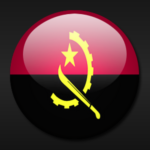(Updated Jan 2006)
Narvik and Einar
Narvik Norway is about as far north as one can get from European civilization and still be part of it. 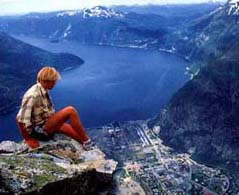 When the sun sets in November it doesn’t rise for three months.
When the sun sets in November it doesn’t rise for three months.
This little city’s life blood flows from the harbor where an enormous iron ore terminal receives hundreds of rail cars per day loaded with raw ore dug from the bowels of Sweden’s Lapland mines a hundred miles inland.
Awaiting the trains are big-bellied cargo ships, tethered by arm-thick moorings, ready to sail to distant smelting plants around the world. This elaborate process begins a thousand feet in Sweden’s underground and terminates in end products for Hong Kong skyscrapers. The Iron Age has never ended.
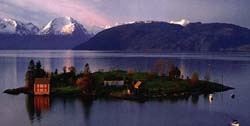 But even the long winter nights are insufficient to daunt the spirits of Einar, a thirty-something gay man who has lived in this port all his life. No small part of the cause for his affirmative attitude is that this chilly port harbors some of the most humanitarian attitudes toward homosexuality to be found in the world. The laws of this country protect the dignity, individual differences and the rights of lesbigay citizens as carefully as any other resident.
But even the long winter nights are insufficient to daunt the spirits of Einar, a thirty-something gay man who has lived in this port all his life. No small part of the cause for his affirmative attitude is that this chilly port harbors some of the most humanitarian attitudes toward homosexuality to be found in the world. The laws of this country protect the dignity, individual differences and the rights of lesbigay citizens as carefully as any other resident.
Very distinct among those privileges, passed by federal legislation in 1994, is recognition of gay couples and straight cohabitants. Their privilege is the legal right to marriage equivalency.
Talking to us in his tidy two bedroom flat, expectedly clean, and warmed by radiators, Einar looked to his future eagerly. “When my boyfriend comes here in November we will get married so he can stay, otherwise he will only have a six-month visa”, he said with casual confidence.
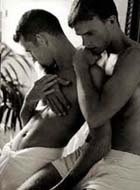 What is also remarkable about this landmark legislation is that it was granted on the first vote when it was presented to the Norwegian congress six years ago. The passage was strongly influenced by the cutting-edge law approved in 1989 by the Danish government that first recognized the legitimacy of gay couples. Sweden soon followed this lead.
What is also remarkable about this landmark legislation is that it was granted on the first vote when it was presented to the Norwegian congress six years ago. The passage was strongly influenced by the cutting-edge law approved in 1989 by the Danish government that first recognized the legitimacy of gay couples. Sweden soon followed this lead.
As Einar described his boyfriend, Ahmed from Algeria, I could not help thinking about he contrast in governmental and religious attitudes between that Muslim country and protestant Norway. Einar is from one of the most progressive nations and Ahmed lives in a harshly negative culture that invalidates homosexuality (ignoring the common homosexual traditions among young premarital men).
History of Decency
Norway’s liberal attitude did not spring from a vacuum or aberration of climate. Since the rise of the great mercantile cities of Brugge, Antwerp and Amsterdam beginning in the 15th century, coinciding with the upheaval of the religious reformation, the old northern Hanseatic world of commerce molded a political trend of decency. It valued the rule of law, disseminating a degree of fairness to all citizens, although unevenly, over the course of five hundred years.
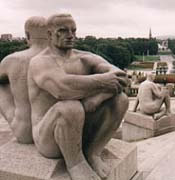 Leaders came to understand the importance and value of independent merchants entering contractual agreements in pursuit of commerce and profit. Stable and reasonable politics, in turn, provided a lawful system of accounts, traffic and banking which assured continuous prosperity and general citizen satisfaction.
Leaders came to understand the importance and value of independent merchants entering contractual agreements in pursuit of commerce and profit. Stable and reasonable politics, in turn, provided a lawful system of accounts, traffic and banking which assured continuous prosperity and general citizen satisfaction.
Human worth, honor, respect and lawful behavior were grounded in political tolerance, fairness and democratically elected representation free of the tyranny of the kings, bishops and petty warlords.
From these centuries of prosperous commerce, fairness in legal matters and respect for the common good emerged in the ‘low countries’ as well as Scandinavia. Such attitudes continue today, manifesting in the new laws regarding homosexuality in 20th century
The current parliament houses a left-of-center socialist government who continue this tradition of respect for the quality of individual lives, gay and straight, young and old. For example, old people, a ‘toss-away’ population in other parts of the world, are here well looked after in efficient, clean and nicely built ‘old homes’ with all their health needs paid for by government programs.
Narvik to Oslo
The drive from Einar’s nippy Narvik to beautiful Bergen in the southwest and over to 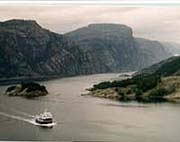 Oslo in the east, follows along Norway’s spectacular spine of countless majestic fjords and prodigious wilderness of lakes, forests, mountains, glaciers, road tunnels, ferry boats and log cabins. The air is clean, the roads uncrowded and pure water spills from mountain streams. Surely the beauty of the land has had some influence on the benevolence of mind in this culture.
Oslo in the east, follows along Norway’s spectacular spine of countless majestic fjords and prodigious wilderness of lakes, forests, mountains, glaciers, road tunnels, ferry boats and log cabins. The air is clean, the roads uncrowded and pure water spills from mountain streams. Surely the beauty of the land has had some influence on the benevolence of mind in this culture.
In the villages, local folks are helpful and easygoing. In the cities such as Trondheim where the king is coronated in the great Nidaros cathedral, traffic is light along clean cobblestone streets, museums are free, the symphony orchestra has a summer festival and the classic architecture is lovingly preserved and mingled with modern designs.
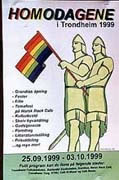 On one of Trondheim’s downtown tree-lined streets is Cafe Remis Pub and Diskotek neatly house in a brick building. On the front wall hangs a large rainbow triangle at eye level. It could easily be torn off–but it wasn’t. In the arched window was a large poster advertising Trondheim’s Pride Week (last week in September) which included films, lectures, dances and ‘grand events’.
On one of Trondheim’s downtown tree-lined streets is Cafe Remis Pub and Diskotek neatly house in a brick building. On the front wall hangs a large rainbow triangle at eye level. It could easily be torn off–but it wasn’t. In the arched window was a large poster advertising Trondheim’s Pride Week (last week in September) which included films, lectures, dances and ‘grand events’.
Further south, glaciers once crawled across the mountains of Norway in eons past, gouging out enough fords and lakes for the whole planet. The most recent melt happened about ten thousand years ago leaving behind some stunning present-day wonders such as the huge Jostedal glacier.
In Bergen, a couple of hundred miles further south, the ancient Hanseatic League warehouses still stand along the waterfront in proud bright colors. Fresh vegetables and flowers are sold at the harborfront market while others huddle over hot coffee or tea. Narrow crooked streets wind their way up the hills to Old World houses looking out to sea.
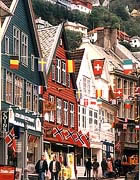 Near the university and the Grieg Concert Hall the gay Cafe Fincken and Club Fincken are self-described as the “only real ‘gay’ place in Bergen”. The street-front cafe is open during the daytime, serving light meals. It looks collegiate with numerous reading materials lying about. At night it is more of a pub. Nearby is the Club Fincken, a disco with dance floor and two bars. These places are small so the mood is friendly and nice and, as expected, it is most crowded Fridays and Saturdays.
Near the university and the Grieg Concert Hall the gay Cafe Fincken and Club Fincken are self-described as the “only real ‘gay’ place in Bergen”. The street-front cafe is open during the daytime, serving light meals. It looks collegiate with numerous reading materials lying about. At night it is more of a pub. Nearby is the Club Fincken, a disco with dance floor and two bars. These places are small so the mood is friendly and nice and, as expected, it is most crowded Fridays and Saturdays.
Sauna and Sexual Attitudes
Bergen has a small sauna with gay nights where local and international visitors can relax, make friends or play. On a visit we met a Coast Guard officer, a Dutch businessman and a Norwegian computer consultant. We chatted in the jacuzzi speaking English of course.
I asked them why many northern Europeans seem to have a free-and-easy attitude about nudity and sexuality. They agreed one of the big differences was the lack of “extreme thinking” from the church or the government. “We have no priests or mullahs screaming at us that sex is bad or that the body is bad,” said the Dutchman. “We teach our children that the body is a natural gift, and responsible sex is part of the body. So it is easy for the children to learn. Sex is not a forbidden fruit here”, he said with a laugh at his own unintended pun.
The officer agreed and also thought that absence of military meddling in the government was also a cause: “the military are always sexually suspicious and so they forbid such freedom. I think it is a homosexual fear, so they are never open about sex–other than to say don’t do it here.” But even that branch of service is changing I noted. According to the International Lesbian and Gay Association (see ILGA link) there is an official ‘Pink Book’, a pamphlet addressed to the gay conscript on how to handle difficulties he may encounter in his service.
It was an informative conversation in a most informal place–but since this was in Norway, it came as no surprise.
San Souci
One of the delightful aspects of these places is their insouciance, the ease and relaxed atmosphere that pervades the afternoons and evenings as friends and couples come in for a drink, food or local chat. I could not help thinking that such nonchalance, such equilibrium was now common in so many gay venues across the world. From China to New Zealand to Chelsea New York City to Bergen, Norway, despite (or because of) still unsolved challenges, homosexual orientation as a social identification has become unquestionably part of the modern mix of culture.
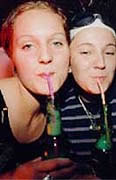 Patrons sitting in Fincken Cafe sipping coffee while reading the newspaper or schmoozing with friends about an upcoming concert feel equal and at peace. There is no threat of harm or restriction on this particular sunny afternoon in the city of Bergen.
Patrons sitting in Fincken Cafe sipping coffee while reading the newspaper or schmoozing with friends about an upcoming concert feel equal and at peace. There is no threat of harm or restriction on this particular sunny afternoon in the city of Bergen.
The closing decade of the twentieth century has been a social renaissance for lesbigays citizens. We have become an indelible and distinct patch in the modern social fabric. It’s a renaissance not without the heavy price of insult, aggression and persecution launched by fundamentalist individuals and institutions. Paradoxically, however, these oppressions have only served to strengthen us and increase our organizations.
Even in liberal Scandinavia, there is still homophobia, insult and assault from fools in scattered areas. But the larger imprint of our identity has been certified at the highest legislative levels. Laws all across the European Union countries have been adjusted to conform to the ‘Code of Amsterdam’, a set of guiding legal policies (not laws) adopted by the member EC nations. These legal codes have been adjudicated by the European Court of Justice including those concerning Human Rights policies.
It is clearly stated that all citizens shall be treated with “equal treatment” under the law. This has meant the elimination of archaic and draconian statutes, once approved by paternalistic and heterosexist lawmakers, which discriminated against racial and sexual minorities and women.
Today most of these laws have fallen by the wayside and have been replaced by more enlightened thought. In Germany and France–and England probably soon–gay and straight cohabiting couples are now being validated by being offered marriage equivalence. Norway, Sweden, Denmark, Holland and Finland have committed to and passed such legislation. It is a new century with new understanding about the varieties of human affections.
Overland to Oslo
Oslo is a long, winding and magnificent drive east of Bergen, but the longer route via coastal Stavanger doubles the length and pleasure for any lover of nature. This path leads across, along and above some of the most magnificent fjords in the world. Surely one of the crown jewels of these colossal inlets is the truly spiritual Lysefjord that slices far inland to the little village of Lysebotn. Along the way upstream is the famous Pulpit Rock that juts out about two thousand feet above the fjord’s water surface.
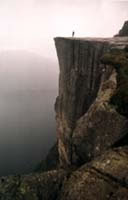 The day before we ferried up the Lysefjord, we climbed the back trail in a delicious rain to the summit of this Rock. The view of the surrounding misty mountains and the dark fjord is nothing short of sublime. From the precipice the drop is so vertically steep as to be vertiginous. Thrill-seeking skydivers leap off this edge and try to land (with prior permission) on one of the ferryboats far below. Our captain, the next day, showed some photos of a successful leap onto his deck.
The day before we ferried up the Lysefjord, we climbed the back trail in a delicious rain to the summit of this Rock. The view of the surrounding misty mountains and the dark fjord is nothing short of sublime. From the precipice the drop is so vertically steep as to be vertiginous. Thrill-seeking skydivers leap off this edge and try to land (with prior permission) on one of the ferryboats far below. Our captain, the next day, showed some photos of a successful leap onto his deck.
Oslo’s Tinghus
Quite far away and far different is another wonder of Norway. It’s found in downtown Oslo. For a gay American couple it’s hard to beat the vicarious delight of our standing together in front of Oslo’s Tinghus (town hall or courthouse) where Norwegian gay and lesbian couples get married. It’s a shiny modern glass and stone building (only a few blocks from the city Domkirke cathedral where we can’t get married).
The rights and privileges of becoming a ‘registered couple’ are described in a brochure that spells out the stipulations and limitations, one of which is that a couple must live together for at least a year prior to registering. To get divorced there are also necessary conditions including making an official 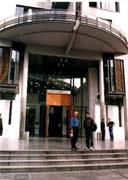 declaration of separation and issuing a release of financial responsibilities to each other.
declaration of separation and issuing a release of financial responsibilities to each other.
Curiously, however, most lesbigay couples do not take ceremonial vows in this place. Perhaps because of the freedom and opportunity that’s already available, many couples do not feel the need for the certificate since their lives are relatively secure at the hands of this culture and this government.
Gays and lesbians are well protected against homophobia by a firm official attitude against discriminative behavior. Since right-or-left-wing religion is neutralized by prevailing government actions, the state Lutheran church clearly takes a back seat in their influence on public attitude. Religious authority is ultimately vested in the secular government here.
As a Swedish friend astutely observed about similar circumstances in his country, “it’s very nice to have not only the legal approval for our marriage but also, at the same time, the moral approval of the church–as a function of the state.”
Bjorn and Tor Otto: Married and Gay
Bjorn and Tor-Otto live in Oslo. They got married several years ago with Tor dressed in his native kommune (county) costume of black knickers, white high socks and a white vest-jacket with embroidered red borders. Bjorn wore a black tuxedo since Oslo (his native commune) doesn’t have a territorial costume.
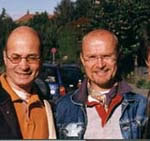 The two men, who met twelve years ago, went with some witnesses to the Tinghus and stood before the judge who gave a small ‘sermon’ on the delights, benefits and responsibilities of commitments. Each looked into one another’s eyes and said “I do” and then wrapped up the occasion by signing the certificate of registration which guarantees them the same privileges and rights as straight couples (except adoption). The wedding party then happily departed for a downtown hotel for a celebration party with more friends.
The two men, who met twelve years ago, went with some witnesses to the Tinghus and stood before the judge who gave a small ‘sermon’ on the delights, benefits and responsibilities of commitments. Each looked into one another’s eyes and said “I do” and then wrapped up the occasion by signing the certificate of registration which guarantees them the same privileges and rights as straight couples (except adoption). The wedding party then happily departed for a downtown hotel for a celebration party with more friends.
Bjorn is a nurse and Tor Otto is an HIV educator and counselor; they live in Oslo near the stunning Vigeland sculpture park. A wide circle of friendships with gay and straight friends nourishes and validates their love.
Oslo is a city of opportunities, in business as well as love. There is also free health care, high level education, as well as fine art and music. This is the land of Edvard Grieg’s famous classical music and Henrik Ibsen’s world-class dramas. Their great collective work ‘Peer Gynt’, a drama with music is renown to music lover everywhere.
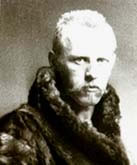 The city is also the home of world-class masculine explorers. The south pole was first ‘conquered’ by the rough and ready Roald Amundsen whose wooden ship ‘Fram’ (“the strongest vessel in the world”) is now housed in its own museum on the waterfront. He shares the spotlight with the famous, and handsome, Arctic explorer Fridtjof Nansen (pictured at right) who navigated the Northwest Passage and came close to walking to the north pole.
The city is also the home of world-class masculine explorers. The south pole was first ‘conquered’ by the rough and ready Roald Amundsen whose wooden ship ‘Fram’ (“the strongest vessel in the world”) is now housed in its own museum on the waterfront. He shares the spotlight with the famous, and handsome, Arctic explorer Fridtjof Nansen (pictured at right) who navigated the Northwest Passage and came close to walking to the north pole.
Adjacent is the Kon-tiki museum housing the more recent exploits of Thor Hyerdahl and his crew. In 1947 they sailed a straw boat, the Kon-tiki, from Pacific Polynesia across thousands of miles to South America to prove a possible theory about trans-Pacific migration by early settlers.
Morten
Morten bounced into Jonas restaurant, one of numerous gay venues in Oslo, to meet us one evening, greeting us with a warm smile like old friends, which in today’s virtual relationships, we were. We met online across seven thousand miles a month before our real-time conversation. Morten was also living within the benefit of same-sex matrimony. He and spouse Rolf were married in 1993 and have been a couple for 21 years.
Over the course of a delicious meal and fine wine, Morten talked less about ‘being’ gay than about the busy march of events in his everyday life. He and Rolf pamper their itchy feet and travel often but not always together. In January Morten was off to Gaza to help train special education teachers preparing to work with mentally handicapped children.
He related that being gay is not a secret for many 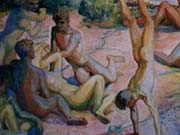 Norwegians as he described how “my ten year old nephew recently heard that I was gay and so he told me ‘I think I’m gay myself.’ I asked him how he knew that and he said ‘I always like to play with other boys and not girls.’ I laughed, but not at him. I think I will wait some years before I take him to a gay bar!” The nephew seemed without shame or fear, according to his uncle, and actually cheerful about declaring his ‘special idea’. “Whether he is or not, is OK, but he knows he is free to say what he is thinking”, confirmed Morten in an assured manner.
Norwegians as he described how “my ten year old nephew recently heard that I was gay and so he told me ‘I think I’m gay myself.’ I asked him how he knew that and he said ‘I always like to play with other boys and not girls.’ I laughed, but not at him. I think I will wait some years before I take him to a gay bar!” The nephew seemed without shame or fear, according to his uncle, and actually cheerful about declaring his ‘special idea’. “Whether he is or not, is OK, but he knows he is free to say what he is thinking”, confirmed Morten in an assured manner.
Before meeting with us, Morten told a younger gay friend he was meeting us at Jonas restaurant. The gen-x-er reacted with disdain: “You’re going to Jonas? But that’s sooo gay!” They laughed together, but the exchange evidenced the shift in attitude from one gay generation to the next. Morten remembered the shadows and murmurs he feared as a young man. Being gay thirty years ago did not always meet with welcoming arms.
Now younger lesbigay cohorts seem to have come full circle, as they prefer to frequent mixed venues instead of exclusively gay clubs or bars. “It’s so boring there–and too expensive,” he had said about Jonas. I couldn’t help thinking about a comment our friend Tuomas made in Helsinki a couple of weeks earlier about young straight people now preferring the gay discos and clubs because the music and sound systems were better. Yet another full circle in our migration toward a more harmonious humanity.
More Oslo Venues
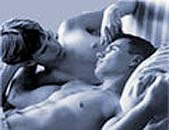 Downstairs from Jonas (around the back into the cellar) was The Backyard, a dark gay bar for men only. Painted in black, it consisted of a bar room, a drinking room and two dim back rooms for late night action. The place seemed much like other dingy holes, a throwback to the dark days of shame and hidden gay life. It happened to be early (10 PM) and there were only two customers sitting at the bar talking. The bartender smiled and assured me the place would be busy by 1 AM; I would be long sleeping by then.
Downstairs from Jonas (around the back into the cellar) was The Backyard, a dark gay bar for men only. Painted in black, it consisted of a bar room, a drinking room and two dim back rooms for late night action. The place seemed much like other dingy holes, a throwback to the dark days of shame and hidden gay life. It happened to be early (10 PM) and there were only two customers sitting at the bar talking. The bartender smiled and assured me the place would be busy by 1 AM; I would be long sleeping by then.
More appealing was the mixed cafe/bar we later visited, Tin Kafe, where the ambience was collegiate and relaxed. Notices on the bulletin board about meetings and organizations and events, lots of reading materials and the buzz of congenial friendship shared at little tables over a glass of brew or coffee.
Upstairs was the headquarters of the Norwegian Association for Lesbian and Gay Liberation (LLH), the largest Norwegian gay rights organization. Founded in 1992, this new organization is the result of half a dozen smaller organizations joining together in the fight for gay and lesbian rights. The association has branches in towns and cities across Norway.
Privilege and Dignity
Over the course of several evenings with Morten, Tor Otto and Bjorn our conversations led into the various topics of gay marriage, social welfare states, 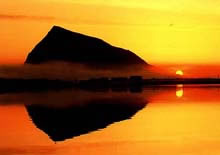 high taxes, HIV and free medical care, the sunny skies of September (“warmest in a century”), free university education, bars and cafes, coming out to parents, and a banquet of everyday considerations such as the high cost of eating out and the inability of gay couples to adopt children. All the privileges (except adoption) and amenities of Norwegian culture were open and available to these men and their partners–and all lesbian citizens equally.
high taxes, HIV and free medical care, the sunny skies of September (“warmest in a century”), free university education, bars and cafes, coming out to parents, and a banquet of everyday considerations such as the high cost of eating out and the inability of gay couples to adopt children. All the privileges (except adoption) and amenities of Norwegian culture were open and available to these men and their partners–and all lesbian citizens equally.
Norway was a refreshing experience of dignified freedom and egalitarian opportunity; a glimpse into a future where human nature is honored, legally and morally, in all it diverse expressions.
Also see:
Gay Norway News & Reports 1995 to present
Gay Norway Photo Gallery


